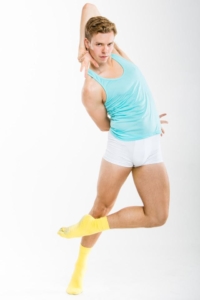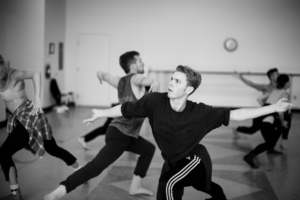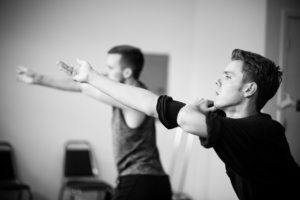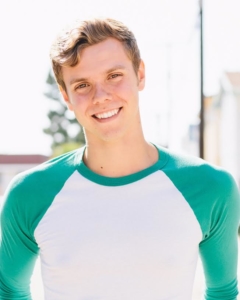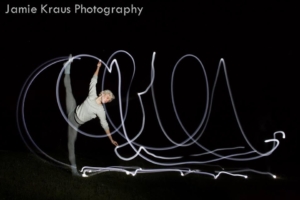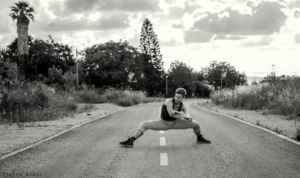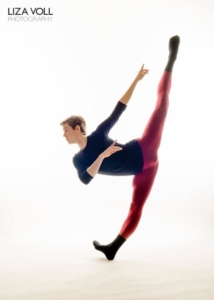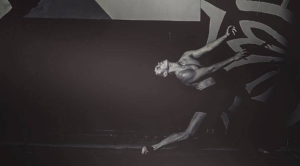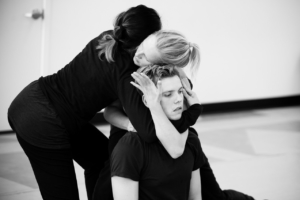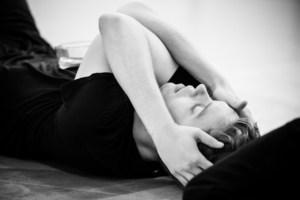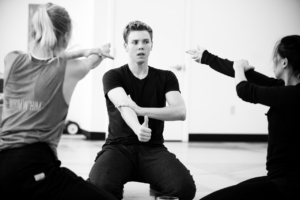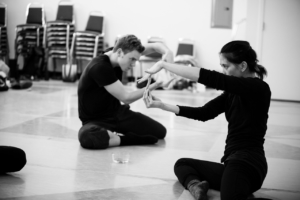One of the things that always strikes me most about dancers in general, and Whim W’Him dancers in particular, is how hard-working, resilient and ingenious they are in dealing with the peculiar complications of a successful contemporary dancer’s life. The normal vicissitudes they encounter not only hone their physical skills and enhance knowledge of a wide range of music and dance styles, but teach all sorts of mechanisms for coping with uncertainty and fostering connection with others. The young lives of both Whim W’Him’s anew dancers amply illustrate these qualities. I first spoke with Adrian Hoffman, because he was about to go away for the summer. (Next post will feature Cameron Birts.)
Adrian grew up in Cambridge, MA, an only child (one of the relatively small number of male dancers, it seems, who did not start dance classes because of a sister). His mother was 40 when he was born. “The arts and physicality” were at the core of his family. Both parents had majored in drama in college, his mother was a potter for 25 years and is now a yoga instructor, while his father too is an artist, and an activist as well (working against discrimination, among other things). “My parents are really two of the most incredible people I’ve met in my life,” says Adrian. There were “no expectations of having to do stuff. They were glad I was happy, had friends, and maybe might want to do more.”
About the age of 9, Adrian took up martial arts, earning a black belt by the time he reached high school. “On the side,” he did musical theater. “I had a great teacher, but I was an awful singer,” he says with his typical self-deprecating humor. “I always got cast as the lead dancer and thought it was just because I was a good at that.” Martial arts helped make him so, and in high school he did more dance. When he performed in Thoroughly Modern Milly and West Side Story with Arlington Children’s Theater, “it felt like a big deal.” Tap and jazz were “what the cool kids did.”
The Cambridge School of Weston was a pretty unusual high school—private with about 300 kids—which offered classical modern classes and held a dance concert once a year. By half way through his freshman year, Adrian was dancing 4-5 days a week. The school had 7 terms, changing out classes every month, with 1-1/2 hours devoted daily to each subject, say ‘Portrayals of masculinity in literature,’ ‘Art and the body—physiology and creative art,’ and ‘Elementary functions.’ When Adrian goes home to Cambridge now, he takes his favorite high school teachers to lunch. The school encouraged living in different ways, being creative with life structures—not necessarily taking the ‘normal’ path. “It could have not worked,” he muses, but “there was lots of passion and excitement.”
On the Whim W’Him website each of the dancers has a quote. Adrian’s is: My goal in life is to have a peak experience every day, whether it be a moment of intense personal connection, pure adrenaline or discovery and when I dance I’m not only guaranteed one, but often all three.” Before he ever took a class, it was as if he knew, “This is what I want to do. As a fact. It’s what I am. So much of my identity is built around it.”
College, however, posed challenges, both expected and not. “I knew I wanted to apply to schools for dance,” Adrian recalls, but he was convinced “that I was not that good on a national level” and he had very modest ambitions. He was advised to think bigger and applied to 13 schools. Early on, he was surprised to realize “that I was a lot better than I thought.” (He also had quite definite tastes. Almost immediately, when he flew out to audition at Indiana, he was clear: “Nope, I don’t want to go here.”) In fact he got in everywhere he applied, except Julliard, and got offers of scholarships as well. The choice in the end came down to the dance programs of New York University or Fordham University. But he couldn’t make up his mind. When consulted about the dilemma, his favorite teacher in school, a math teacher, suggested that he use a totally analytical approach. Assigning ‘odds’ to NYU and ‘evens’ to Fordham, he’d go with a randomly generated number from 1 to 10—a sophisticated method of flipping a coin. The number to come up was 10.
So Adrian set off to Fordham. “It was not,” he says honestly, “a great experience on the whole. It was a very large school and not much support—20-30 people per dance class.” In glaring contrast to his high school, “I didn’t feel helped at all.” In the beginning, especially, it was very difficult. By the end of the first year he wanted to quit dance. “I thought I was not cut out for it.” He took a bunch of time off from dancing in the summer to try something else, thinking, ‘if you miss it, you can go back.’
He did and he did. At the end of this rocky interlude, Adrian “felt frustrated that I had let someone take away my love and passion and internal fire and decided I needed to prove them wrong.” So he figured out the lessons he needed to learn—how to stand out among 40 dancers, how to accept rejection and be glad for successful friends. That “reformulation,” as he calls it, “made the whole experience much better.”
And in his sophomore year, out of 250 students of the Ailey program at Fordham, Adrian was as one of 6 picked to participate in the Jacobs Pillow Contemporary Program under the direction of Milton Myers (24 are selected internationally in all). He had gone from unappreciated to chosen. “For the first time,” he says, “I felt I could be a professional dancer.” From something as small as playing backstage with a Dance Theatre of Harlem dancer’s dog to vivid glimpses of the dancer’s performing life, “Being there with those dancers as people made me want that and think it could happen for me.”
Sophomore year was also big because the first 40 dance students to sign up were allowed to participate in a masterclass with an Israeli group. “I loved it and the teachers!” says Adrian. When a free audition was offered for a dance program in Israel, he went. “Just treat it as a master class,” they said, and he wasn’t hoping for anything. After all, the Fordham dance director had stipulated no study abroad.
But then the Israelis talked about Kibbutz Ga’aton, where “Dance is about being a community.” “Not what I thought dance was at all,” recalls Adrian, “I thought of it as a hostile, competitive environment.” With that, he told himself, “If I get in, I owe it to myself to try.” He went to the office of the Fordham dance program director. “She said, if I could do all the accreditation to do with going, she said I could do it.” Seven months followed of “essays and email.” Adrian notes, “I am very persistent when I find something I want. I work to make it happen.”
“The Dance Village” at Kibbutz Ga’aton was founded by Yehudit Arnon, who, in 1944 at the Birkenau concentration camp, was told that the SS wanted her to dance at their Christmas party. She refused, but instead of shooting her on the spot, they sent her outside, barefoot in the snow, to freeze to death. “As her legs went numb, she swore to herself that if she survives, she’d devote the rest of her life to dance,” one account reads. Arnon was standing before a firing squad some time later, when the Russians broke in and she was spared.
Adrian’s 5 intense months in Israel had a profound effect on his attitudes, toward dance and life. The kibbutz also manufactured cardboard, raised 20,000 chickens (“we smelled them though we didn’t see them”) and made fruit liqueurs. The dance village itself had a café, a grocery store and a pub (in a former silo).
In the program were 40 people from all over—Colombia, Canada, Germany, India, Italy and Asia. “Some couldn’t speak English, but all of them loved dance.” From the gorgeous field of flowers to the sequestration away from society to 8 hours a day of dance to the untold hours of conversation, it was a unique interlude. The kibbutz was near the northern mountains and Mediterranean, and almost every weekend Adrian and his new acquaintances traveled to Tel Aviv and elsewhere. “There’s a lot to unpack in Israel,” he reports, “But just physically, as a country it’s incredible. I have friends from all over the world now and keep in touch with almost all of them.”
Back in college for his senior year, Adrian “had blinders on. It was get out and get a job. Keep your eye on the finish.” What with a double minor in math and philosophy, outside work and school, it was a grueling schedule (one time he even fainted). Since the goal was to get a job, so he auditioned for everything, and that included Whim W’Him. “A friend kept telling me about WW and how amazing it was. She and I went to audition together.” He loved the way the audition was conducted and how the Whimmers moved. That was Feb 2016 at the Alvin Ailey studios in NYC. “It was the kind of movement I want. When I danced with Tory [Peil], she said, ‘I love the way you’re doing the duet.'” He partnered Liane [Aung] too. Whim W’Him artistic director “Olivier [Wevers] was so sweet and so much fun.” Although Olivier did ask him to stay in contact, there wasn’t a contract available at that time, and Adrian went on to other activities.
But he hadn’t given up on Whim W’Him, where he visited and participated twice when the Madboots piece was being rehearsed in June of 2016, after his college graduation, before going down to Los Angeles on vacation. One thing led to another there, and when a woman in a class Adrian was taking told him, “I’m shooting a dance film, you’d be great in it,” he canceled a return trip to New York. After finishing off a gig in Vancouver, “I arrived back in LA at 9 AM and was shooting the film at 10.”
Says Adrian, “The universe was clear. This was my next step. I had no connections in LA, but moved there anyway and bought my first car and rented my first apartment. It was a crash course in how to be an adult—paying bills, budgeting, lots of networking.” It was a big decision to make spontaneously, but it ended up being good. Within a few months he was able to go full-time freelance, supplementing with videos and TV.
Later that year, in November, Adrian again came up to Seattle, to see a friend. He flew out on election eve. With his phone on air mode, he didn’t realize the unexpected turn events were taking. Three hours later when he landed, he says, “It was like the Twilight Zone.” The next day he came to a rehearsal with Whim W’Him for Larry’s Keigwin‘s piece for the January 2017 show. Everyone held each other. They sat around a table listening to the concession speech. Justin gave an anti-Trump yoga class before rehearsal. It was a deep bonding experience.
Then Larry said, “This is the reality, but we’re going to make art.” It was the perfect antidote.
In each of his encounters with Whim W’Him, Adrian recalls, “I had so much fun. There is so much humility and mutual respect. They like each other and what they’re doing. It was like on the kibbutz—no one better than the others.” And again Olivier was friendly and welcoming. But by this time, Adrian’s life was in LA. He flew back there to resume his career where he had built a community over the past year.
Then early on a Friday in May of this year, Adrian’s phone rang. He rolled over to see who the call was from. It was Olivier: “A contract just opened up. Would you be interested? And if so could you start in 2 weeks?”
Adrian’s first reaction was to feel angry. This was exactly what he had wanted—a year ago. Now everything was already settled in LA. He’d signed a lease. All his work was set up and planned out week-by-week for a year ahead. But his new boyfriend told him, “I think you need to leave and do this.” And when called Patrick Kilbane, who was leaving Whim W’Him to dance with Ballet BC, Patrick said, “You’d be an idiot not to do it.” He called Olivier to say he would come.
The Whim W’Him dancers, says Adrian, were incredible. Karl found him a place to live, Liane offered her parents’ garage in LA to park his car, without even having to ask them. Jim left a lovely 30-second message on his phone. “The love so immediate and so beyond what I was anticipating.” Adrian still sounds a bit amazed. “Lots of companies are similar in size, but don’t meld the way Whim does. In LA, I learned to free lance, put up with last minute calculations, take on anything—tap, juggling.” This spring and early summer, he was working with a different choreographer every two weeks. (And in off times he still dances in LA.) Sounds like heaven…
Photo Credit: All Whim W’Him images by Bamberg Fine Art Photography
